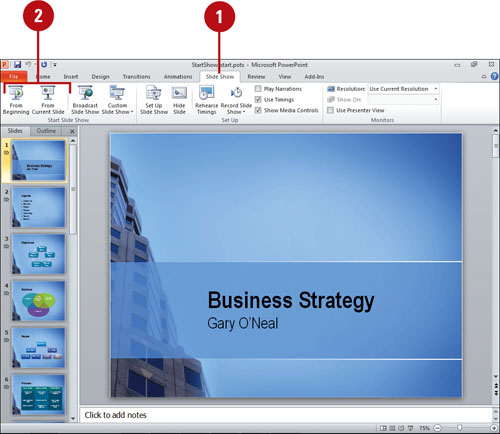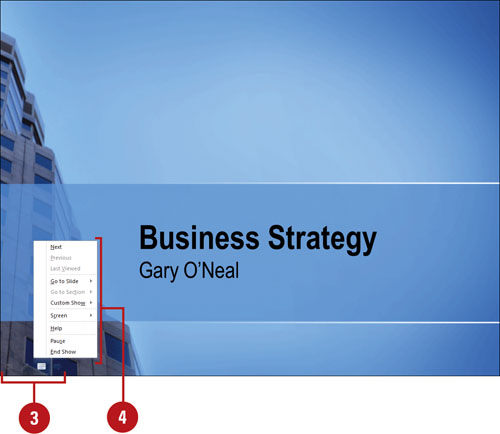Once you have set up your slide show, you can start
the show at any time. As you run your slide show, you can use the Slide
Show toolbar, or Pop-up toolbar, to access certain PowerPoint commands
without leaving Slide Show view. If your show is running at a kiosk, you
might want to disable this feature.
Start a Slide Show and Display the Slide Show Toolbar
 Click the Slide Show tab. Click the Slide Show tab.
Timesaver
Click the Slide Show View button on the Status bar to start a slide show quickly from the current slide.
 Click the From Beginning or From Current Slide button. Click the From Beginning or From Current Slide button.
  Move the mouse pointer to display the Slide Show toolbar. Move the mouse pointer to display the Slide Show toolbar.
 Click a button on the Slide Show toolbar to move to the next or previous slide, or navigate the slide show, or end the show. Click a button on the Slide Show toolbar to move to the next or previous slide, or navigate the slide show, or end the show.
Timesaver
Press Esc to stop a slide show. -

Did You Know?
You can set Slide Show options.
Click the File tab, click Options, click Advanced, select the slide show
and pop-up toolbar check box options you want (Show Menu On Right
Click, Show Popup Toolbar, Prompt To Keep Ink Annotations When Exiting,
or End With Black Slide), and then click OK.
Set Slide Show Options
 Click the File tab, and then click Options. Click the File tab, and then click Options.
 In the left pane, click Advanced. In the left pane, click Advanced.
 Select the slide show and pop-up toolbar check box options you want. Select the slide show and pop-up toolbar check box options you want.
- Show menu on right mouse click. Select to show a shortcut menu when you right-click a slide during a slide show.
- Show popup toolbar. Select to show the popup toolbar at the bottom of a full screen presentation.
- Prompt to keep ink annotations when exiting. Select to be prompted to save your changes when you write on slides during a slide show.
- End with black slide. Select to insert a black slide at the end of the presentation.
 Click OK. Click OK.

|